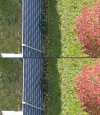Hi there! 
I just had a closer look at two photos I took a few days ago - one taken with 12 MP, the other with 50 MP picture resolution.
I resized the 12 MP photo to the exact size of the 50 MP photo - using Affinity Photo, a serious photo editor.
Just see the results: Do you see any significant differences between the image sections I picked?
For me, it looks like the option for taking 50 MP photos does NOT take 50 MP photos at all - just grabs a 12 MP picture and saves it as a 50 MP picture, just like you can do with any post-processing software. There's just tiny differences (slightly lower histogram and contrast values), likely to be caused by minor changes of lighting conditions as the photos were taken about 20 seconds apart.
What's your opinion?
Please also do your own tests and share the results. Let's find out if it's the same everywhere or just a "specialty" of my Nano.
Autel: Your comments would be highly appreciated.
I just had a closer look at two photos I took a few days ago - one taken with 12 MP, the other with 50 MP picture resolution.
I resized the 12 MP photo to the exact size of the 50 MP photo - using Affinity Photo, a serious photo editor.
Just see the results: Do you see any significant differences between the image sections I picked?
For me, it looks like the option for taking 50 MP photos does NOT take 50 MP photos at all - just grabs a 12 MP picture and saves it as a 50 MP picture, just like you can do with any post-processing software. There's just tiny differences (slightly lower histogram and contrast values), likely to be caused by minor changes of lighting conditions as the photos were taken about 20 seconds apart.
What's your opinion?
Please also do your own tests and share the results. Let's find out if it's the same everywhere or just a "specialty" of my Nano.
Autel: Your comments would be highly appreciated.
Attachments
Last edited:





